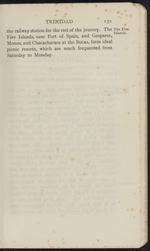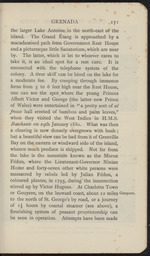| 1 |
 |
“...TRINIDAD
IS1
the railway station for the rest of the journey. The TheFw*
Five Islands, near Port of Spain, and Gasparee,
Monos, and Chacachacare at the Bocas, form ideal
picnic resorts, which are much frequented from
Saturday to Monday....”
|
|
| 2 |
 |
“...GRENADA
I71
the larger Lake Antoine in the north-east of the
island. The Grand Étang is approached by a
macadamised path from Government Rest House
and a picturesque little Sanatorium, which are near
by. The latter, which is let to whoever cares to
take it, is an ideal spot for a rest cure. It is
connected with the telephone system of the
colony. A river skiff can be hired on the lake for
a moderate fee. By creeping through immense
ferns from 5 to 6 feet high near the Rest House,
one can see the spot where the young Princes
Albert Victor and George (the latter now Prince
of Wales) were entertained in “a pretty sort of al
fresco hall erected of bamboo and palm leaves,”
when they visited the West Indies in H.M.S.
Bacchante on 29th January 1880. What was then
a clearing is now densely overgrown with bush;
but a beautiful view can be had from it of Grenville
Bay on the eastern or windward side of the island,
whence much produce is shipped. Not far from
the lake is the mountain known as the...”
|
|
| 3 |
 |
“...LUCIA
193
evacuate the island, only visiting it for the purpose
of securing wood and water until some definite
decision was arrived at. In 1748 the island was
declared by the Treaty of Aix-la-Chapelle to be
neutral. St. Lucia capitulated to Admiral Rodney
and General Monckton in 1762, but it was restored
to France in the following year by the Treaty of
Paris. When war broke out with France in 1778,
Rodney impressed upon the Government the
necessity of taking St. Lucia which he regarded
as an ideal naval base, and a powerful body of
troops was landed at Grand Cul de Sac Bay.
Count d’Estaing, who opposed them with a strong
force, was beaten off, and until the end of the war
the island remained British, in spite of an attempt
to recapture it in 1781; and it was from Gros
Islet Bay, at the north-east of the island, that
Rodney sailed with his fleet and inflicted a deci-
sive defeat on Count de Grasse between Dominica
and Guadeloupe on the memorable 12th April
1782. St. Lucia was restored to...”
|
|
| 4 |
 |
“...Tennis.
South Soufrière, hour’s ride from Plymouth, Principal
and Gage’s Soufrière, only half-an-hour’s ride from
Plymouth, should both be seen. The former is
beautifully situated on the south side of Chances
Mountain, which rises to a height of 3002 feet in
the southern group. It has several boiling springs
and vents from which steam and sulphurous
vapours emanate. Around it there are deposits
of gypsum and sulphur. The other Soufrière is
quite near Plymouth, and is easily accessible. It
is an ideal spot for the erection of a bathing
establishment, as there are hot and cold springs
near it, the former being impregnated with mineral
matter, chiefly calcium chloride. Visits may also
be made to lime, cotton, and cocoa plantations.
Few islands offer greater facilities for growing
citrus fruits, spices, vanilla, and tropical produce
generally....”
|
|
